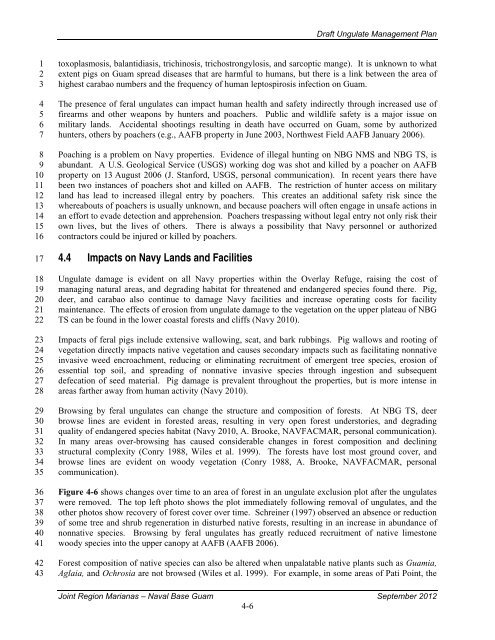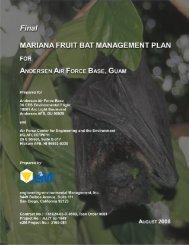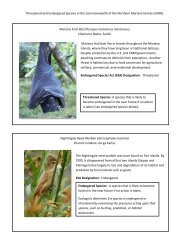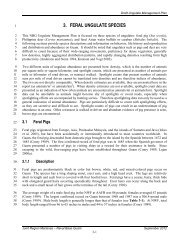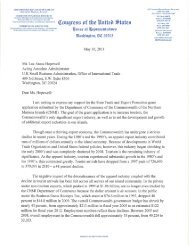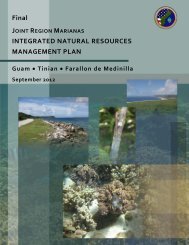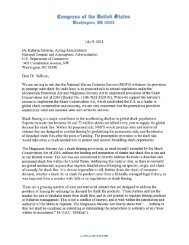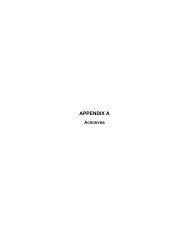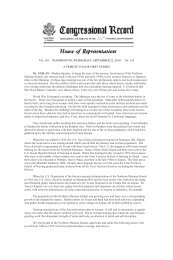4. FERAL UNGULATE SPECIES IMPACTS ON NAVY LANDS
4. FERAL UNGULATE SPECIES IMPACTS ON NAVY LANDS
4. FERAL UNGULATE SPECIES IMPACTS ON NAVY LANDS
You also want an ePaper? Increase the reach of your titles
YUMPU automatically turns print PDFs into web optimized ePapers that Google loves.
1<br />
2<br />
3<br />
4<br />
5<br />
6<br />
7<br />
8<br />
9<br />
10<br />
11<br />
12<br />
13<br />
14<br />
15<br />
16<br />
17<br />
18<br />
19<br />
20<br />
21<br />
22<br />
23<br />
24<br />
25<br />
26<br />
27<br />
28<br />
29<br />
30<br />
31<br />
32<br />
33<br />
34<br />
35<br />
36<br />
37<br />
38<br />
39<br />
40<br />
41<br />
42<br />
43<br />
Draft Ungulate Management Plan<br />
toxoplasmosis, balantidiasis, trichinosis, trichostrongylosis, and sarcoptic mange). It is unknown to what<br />
extent pigs on Guam spread diseases that are harmful to humans, but there is a link between the area of<br />
highest carabao numbers and the frequency of human leptospirosis infection on Guam.<br />
The presence of feral ungulates can impact human health and safety indirectly through increased use of<br />
firearms and other weapons by hunters and poachers. Public and wildlife safety is a major issue on<br />
military lands. Accidental shootings resulting in death have occurred on Guam, some by authorized<br />
hunters, others by poachers (e.g., AAFB property in June 2003, Northwest Field AAFB January 2006).<br />
Poaching is a problem on Navy properties. Evidence of illegal hunting on NBG NMS and NBG TS, is<br />
abundant. A U.S. Geological Service (USGS) working dog was shot and killed by a poacher on AAFB<br />
property on 13 August 2006 (J. Stanford, USGS, personal communication). In recent years there have<br />
been two instances of poachers shot and killed on AAFB. The restriction of hunter access on military<br />
land has lead to increased illegal entry by poachers. This creates an additional safety risk since the<br />
whereabouts of poachers is usually unknown, and because poachers will often engage in unsafe actions in<br />
an effort to evade detection and apprehension. Poachers trespassing without legal entry not only risk their<br />
own lives, but the lives of others. There is always a possibility that Navy personnel or authorized<br />
contractors could be injured or killed by poachers.<br />
<strong>4.</strong>4 Impacts on Navy Lands and Facilities<br />
Ungulate damage is evident on all Navy properties within the Overlay Refuge, raising the cost of<br />
managing natural areas, and degrading habitat for threatened and endangered species found there. Pig,<br />
deer, and carabao also continue to damage Navy facilities and increase operating costs for facility<br />
maintenance. The effects of erosion from ungulate damage to the vegetation on the upper plateau of NBG<br />
TS can be found in the lower coastal forests and cliffs (Navy 2010).<br />
Impacts of feral pigs include extensive wallowing, scat, and bark rubbings. Pig wallows and rooting of<br />
vegetation directly impacts native vegetation and causes secondary impacts such as facilitating nonnative<br />
invasive weed encroachment, reducing or eliminating recruitment of emergent tree species, erosion of<br />
essential top soil, and spreading of nonnative invasive species through ingestion and subsequent<br />
defecation of seed material. Pig damage is prevalent throughout the properties, but is more intense in<br />
areas farther away from human activity (Navy 2010).<br />
Browsing by feral ungulates can change the structure and composition of forests. At NBG TS, deer<br />
browse lines are evident in forested areas, resulting in very open forest understories, and degrading<br />
quality of endangered species habitat (Navy 2010, A. Brooke, NAVFACMAR, personal communication).<br />
In many areas over-browsing has caused considerable changes in forest composition and declining<br />
structural complexity (Conry 1988, Wiles et al. 1999). The forests have lost most ground cover, and<br />
browse lines are evident on woody vegetation (Conry 1988, A. Brooke, NAVFACMAR, personal<br />
communication).<br />
Figure 4-6 shows changes over time to an area of forest in an ungulate exclusion plot after the ungulates<br />
were removed. The top left photo shows the plot immediately following removal of ungulates, and the<br />
other photos show recovery of forest cover over time. Schreiner (1997) observed an absence or reduction<br />
of some tree and shrub regeneration in disturbed native forests, resulting in an increase in abundance of<br />
nonnative species. Browsing by feral ungulates has greatly reduced recruitment of native limestone<br />
woody species into the upper canopy at AAFB (AAFB 2006).<br />
Forest composition of native species can also be altered when unpalatable native plants such as Guamia,<br />
Aglaia, and Ochrosia are not browsed (Wiles et al. 1999). For example, in some areas of Pati Point, the<br />
Joint Region Marianas – Naval Base Guam September 2012<br />
4-6


